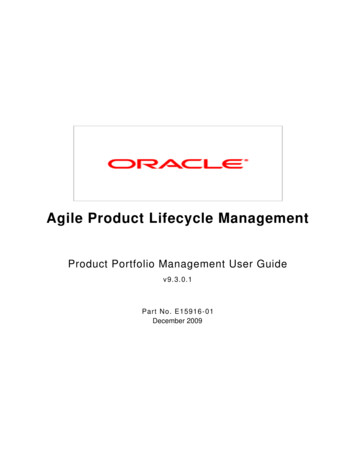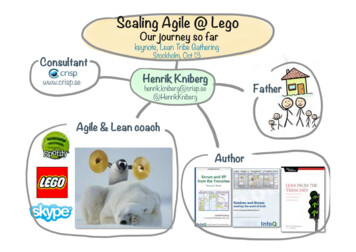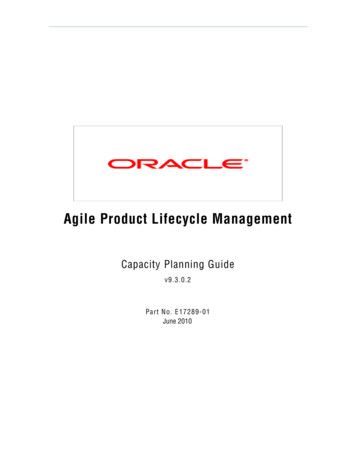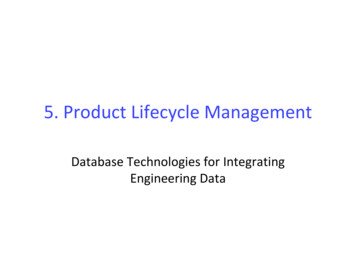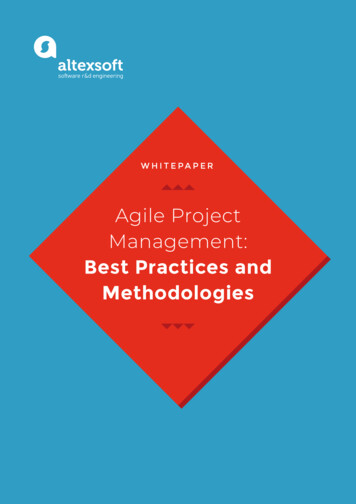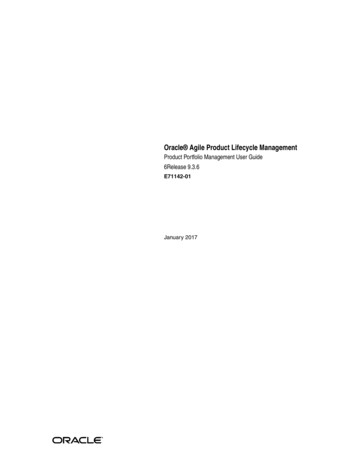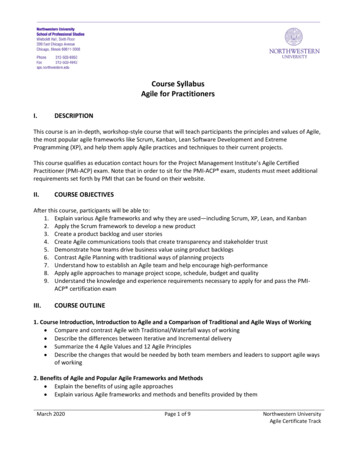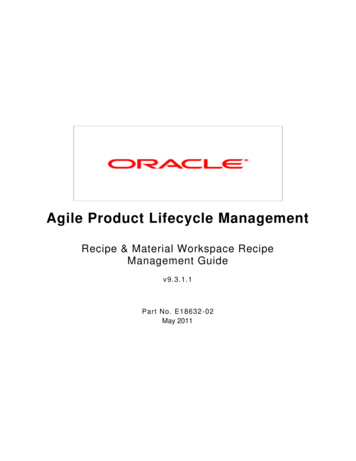
Transcription
Agile Product Lifecycle ManagementRecipe & Material Workspace RecipeManagement Guidev9.3.1.1Part No. E18632-02May 2011
Recipe & Material Workspace Recipe Management GuideOracle CopyrightCopyright 1995, 2011, Oracle and/or its affiliates. All rights reserved.This software and related documentation are provided under a license agreement containingrestrictions on use and disclosure and are protected by intellectual property laws. Except asexpressly permitted in your license agreement or allowed by law, you may not use, copy,reproduce, translate, broadcast, modify, license, transmit, distribute, exhibit, perform, publish ordisplay any part, in any form, or by any means. Reverse engineering, disassembly, or decompilationof this software, unless required by law for interoperability, is prohibited.The information contained herein is subject to change without notice and is not warranted to beerror-free. If you find any errors, please report them to us in writing.If this software or related documentation is delivered to the U.S. Government or anyone licensing iton behalf of the U.S. Government, the following notice is applicable:U.S. GOVERNMENT RIGHTSPrograms, software, databases, and related documentation and technical data delivered to U.S.Government customers are "commercial computer software" or "commercial technical data"pursuant to the applicable Federal Acquisition Regulation and agency-specific supplementalregulations. As such, the use, duplication, disclosure, modification, and adaptation shall be subjectto the restrictions and license terms set forth in the applicable Government contract, and, to theextent applicable by the terms of the Government contract, the additional rights set forth in FAR52.227-19, Commercial Computer Software License (December 2007). Oracle USA, Inc., 500Oracle Parkway, Redwood City, CA 94065.This software is developed for general use in a variety of information management applications. It isnot developed or intended for use in any inherently dangerous applications, including applicationswhich may create a risk of personal injury. If you use this software in dangerous applications, thenyou shall be responsible to take all appropriate fail-safe, backup, redundancy and other measuresto ensure the safe use of this software. Oracle Corporation and its affiliates disclaim any liability forany damages caused by use of this software in dangerous applications.Oracle and Java are registered trademarks of Oracle Corporation and/or its affiliates. Other namesmay be trademarks of their respective owners.This software and documentation may provide access to or information on content, products andservices from third parties. Oracle Corporation and its affiliates are not responsible for andexpressly disclaim all warranties of any kind with respect to third party content, products andservices. Oracle Corporation and its affiliates will not be responsible for any loss, costs, or damagesincurred due to your access to or use of third party content, products or services. The RMW productincludes software developed by the Visigoth Software Society.iiAgile Product Lifecycle Management
CONTENTSOracle Copyright . iiIntroduction to Recipe Management . 1About this Guide .1Recipe & Material Workspace Documentation .2Recipes in RMW - An Overview .2Types of Recipes .3Recipe and Recipe Templates .4Recipe Components .4Procedure . 4Recipe Elements . 5Recipe Actions . 5Bill Of Processes . 5Bill Of Material . 6Bill Of Equipment . 6Bill Of Assays . 6Bill Of Standards . 6Output . 7Authoring Recipes . 9Creating Recipe Action Template .10Editing a Recipe Action Template . 11Changing Lifecycle Phases of Recipe Action Template . 12Creating Recipe Element Template .13Editing a Recipe Element Template. 14Changing Lifecycle Phase of Recipe Element Template . 14Creating a Recipe .15Editing a Recipe . 18Creating a Work Request from a Recipe .19Batch ML .20Working with Recipe Variables and Parameters . 23Variables .23Formulation of a Variable . 23Creating a Variable . 25Managing Variables. 26Resolving Variables . 27v9.3.1.1iii
Recipe & Material Workspace Recipe Management GuideParameters .28Creating Parameters . 28Managing Parameters. 30Recipe Editors . 31Working with Text Editor.31Working with SFC Editor .32Components of SFC . 33Adding Recipe Actions . 34Adding Recipe Elements . 35Conditional Branching . 35Parallel Branching . 36Traversing between the Recipe Elements. 37ivAgile Product Lifecycle Management
PrefaceOracle's Agile PLM documentation set includes Adobe Acrobat PDF files. The Oracle TechnologyNetwork (OTN) Web site ile-085940.htmlcontains the latest versions of the Agile PLM PDF files. You can view or download these manualsfrom the Web site, or you can ask your Agile administrator if there is an Agile PLM Documentationfolder available on your network from which you can access the Agile PLM documentation (PDF)files.No teTo read the PDF files, you must use the free Adobe Acrobat Reader version 9.0 or later.This program can be downloaded from the Adobe Web site http://www.adobe.com.The Oracle Technology Network (OTN) Web n/agile-085940.html can be accessed through Help Manuals in both Agile Web Client and Agile Java Client. If you need additional assistance orinformation, please contact My Oracle Support (https://support.oracle.com) for assistance.No teBefore calling Oracle Support about a problem with an Agile PLM manual, please havethe full part number, which is located on the title page.TTY Access to Oracle Support ServicesOracle provides dedicated Text Telephone (TTY) access to Oracle Support Services within theUnited States of America 24 hours a day, 7 days a week. For TTY support, call 800.446.2398.Outside the United States, call 1.407.458.2479.ReadmeAny last-minute information about Agile PLM can be found in the Readme file on the OracleTechnology Network (OTN) Web site ile085940.html.Agile Training AidsGo to the Oracle University Web country new.html for more information on AgileTraining offerings.Accessibility of Code Examples in DocumentationScreen readers may not always correctly read the code examples in this document. Theconventions for writing code require that closing braces should appear on an otherwise empty line;however, some screen readers may not always read a line of text that consists solely of a bracket orbrace.This documentation may contain links to Web sites of other companies or organizations that Oracledoes not own or control. Oracle neither evaluates nor makes any representations regarding theaccessibility of these Web sites.v9.3.1.1v
viAgile Product Lifecycle Management
Chapter 1Introduction to Recipe ManagementThis chapter includes the following: About this Guide . 1Recipe & Material Workspace Documentation . 2Recipes in RMW - An Overview . 2Types of Recipes . 3Recipe and Recipe Templates. 4Recipe Components . 4The Recipe Management module within the Agile PLM Recipe & Material Workspace (RMW)solution provides integrated recipe authoring capabilities that help you to track the developmentprocess of a product. In RMW, recipes are integrated with the related Bill of Materials (BOM), Bill ofEquipment (BOE), and Bill of Processes (BOP) to maintain a complete and reliable electronicrecord.The primary benefits of using RMW for recipe management are: Re-usability of recipe objects — Once created, each recipe object can be reused in otherrecipes and experiments or work requests, across multiple sites. Recipe and experiment results captured in electronic format — Recipes, experiments, and billsneed not be created manually (in paper format) for each recipe instance. Ability to import and export recipes in XML — Eliminates manual errors during tech transfers;the transfer can be completed in a fraction of the usual time. Greatly reduced effort in authoring — Easy-to-use graphical and text editors simplify andexpedite the recipe authoring process.About this GuideThis guide provides information on all the features and functionality of the RMW MaterialManagement module. It also covers instructions on how to use the various menus and commandsavailable on the RMW User Interface to create and manage material objects. The features that arevisible to you on the interface are determined by the access privileges assigned to you by anadministrator.v9.3.1.11
Recipe & Material Workspace Recipe Management GuideRecipe & Material Workspace DocumentationThe complete list of RMW manuals is provided here for the benefit of users and administrators ofthe RMW solution. Getting Started with Recipe & Material Workspace — describes common concepts, basicnavigation, searches and workflows. Also covers how to work with reports, standards, andenvironmental conditions. Recipe & Material Workspace Administrator Guide — describes all administration andconfiguration information including Agile PLM integration requirements. Recipe & Material Workspace Process Management Guide — describes the features of theProcess module, covering the creation and execution of projects and campaigns, controlrecipes, and work requests. Recipe & Material Workspace Recipe Management Guide — describes the features of theRecipe module, covering the authoring and management of recipes and recipe templates. Recipe & Material Workspace Material Management Guide — describes the features of theMaterials module, covering how to work with material requests, inventory, and allocation. Alsocovers how to manage analytical activities. Recipe & Material Workspace Equipment Management Guide — describes the features of theEquipment module, covering equipment qualification, loan, lease, and reservation. Recipe & Material Workspace Import /Export Guide — describes how to export and importRMW business and administrator objects from a source system to a target system.RMW is accessed only through the Agile PLM user interface. Refer to Getting Started with AgilePLM along with the Agile PLM Administrator Guide for a thorough understanding of PLM processes.The complete set of Agile PLM documentation, including RMW documentation, is available on theOracle Technology Network (OTN) Web n/agile-085940.html.Recipes in RMW - An OverviewA Recipe contains the minimum set of information about the developmental requirements of aspecific product. Recipes generally include instructions about gathering and combining rawmaterial, the type of equipment to be used, and processes to be followed to create the targetproduct.In RMW, instructions in a recipe can have embedded variables (placeholders) for generic resourcenames – for resources such as equipment, material, or standards. This type of authoring ensuresthat the recipes can be reused as required, with the variables resolved to specific values for eachuse in a project or campaign.Within the product development cycle for a target material, as a project or campaign gets underway,the recipe that defines the process of creating that product is attached to a process step. Generic2Agile Product Lifecycle Management
Chapter 1: Introduction to Recipe Managementrecipes are converted to project-specific Control Recipes, and these are in turn used to create WorkRequests. Work Requests can be completed in an experiment, or logged as a production batch record.Recipes can be versioned based on feedback from the pilot plant or commercial operations.Types of RecipesRecipes are classified into the following types: General Recipe: A General Recipe is the basis for lower-level recipes and used at the companylevel. It specifies the raw materials, quantities (of raw material) required and processinginformation for making the product. It does not include information about the Site/Equipmentinvolved in the manufacture of a product. It only communicates processing requirements tomultiple manufacturing sites. Site Recipe: A Site Recipe is a derived form of a general recipe that takes into consideration thespecific conditions or constraints of a particular manufacturing site. It provides the level of detailnecessary for site-level, long-term production scheduling.Site recipes contain information tailored for a target location. These can be modified for locallanguage, local measurements and availability of local raw materials and include informationabout on-site processing, storage capacity, and constraints. From a general recipe, you canderive multiple site recipes, each covering a part of the general recipe that may beimplemented at a specific site. Master Recipe: A master recipe is targeted to a processing area and is derived from a site recipeor created directly. Master recipes depend on equipment types or classes, such as a glasslined reactor or mixing vessel. These recipes can contain product-specific information requiredfor detailed scheduling, such as equipment requirements. But unlike the general and siterecipes, S88 batch control requires a master recipe. A master recipe is the template for recipesused to create individual batches. Without this template, no specific batch recipes can becreated, and therefore, no batches can be produced. Control Recipe: A control recipe is used to create a single, specific batch. It starts as a copy of amaster/general/site recipe and is modified as necessary to create a batch. The modificationsmay account for batch size, characteristics of raw materials on-site (e.g., potency), or actualequipment to be used. While several (dozens, hundreds, or thousands of) batches may use thesame master recipe, every batch has a single control recipe unique to that batch and that batchalone.Two control recipes may be identical in ingredients, quantities, or equipment used, but they areidentified individually. Control recipes unique to individual batches allow product tracking orgenealogy tracking to occur.For complete information on Control Recipes, see Recipe & Material Workspace ProcessManagement Guide.v9.3.1.13
Recipe & Material Workspace Recipe Management GuideRecipe and Recipe TemplatesThe difference between a Recipe and a Recipe Template is that templates have unresolved variablesand parameters, with undefined constraints. A Recipe needs to be complete and ready before youcan execute it.Recipe ComponentsA Recipe in RMW is a structured compilation of a set of components as shown below. The followingsections describe each component.ProcedureIn RMW, a recipe procedure is a structural representation of Recipe Elements, Recipe Actions, andassociated objects. The RMW user interface allows you to create Recipe Element Templates andRecipe Action Templates which can then be reused while authoring recipes.4Agile Product Lifecycle Management
Chapter 1: Introduction to Recipe ManagementRecipe ElementsA recipe element is a procedural element that is used to represent an entity in procedure functioncharts. A recipe element can be any of the following: Unit Procedure - an ordered set of operations carried out to completion on a single unit. It is acontiguous production sequence acting on a single unit only. Only one unit procedure isallowed to be active on a unit at a time. Multiple unit procedures can run concurrently as part ofthe same procedure, as long as they are active on different units. Unit procedures can containoperations, phases and actions. Operation - an ordered set of phases carried out to completion within a single unit. An operationusually takes the material being processed through some type of physical, chemical, orbiological change. Like unit procedures, the standard presumes only one operation is active ona particular unit at a time. Operations can contain phases and actions. Phase - A phase is the smallest element of procedural control that can accomplish processoriented tasks. A phase performs unique and generally independent, basic process-orientedfunctions, such as charging an ingredient or agitating a tank. All other elements (procedures,unit procedures, and operations) group, organize, and direct the phases.Recipe ActionsA Recipe Action contains an instruction to perform a unique and generally independent action relatedto the manufacturing process. It allows the author to specify the following details: Variables – resources you can use. For example: Equipment, Material, and Standards Parameters – parameters you need to measure or control Second Person Verification – whether you require electronic signature and second personverification. Electronic Signature indicates that an operator completed the taskSecond Person Verification indicates that a second person or automation verified theaction or measurementExecution mode – manual or automatic.Bill Of ProcessesA Work Request for a target material contains a list of materials, equipment, process steps,standards, control parameters, and measured parameters which may use assays. At the heart ofthe creating a Work Request is a series of steps that go into creating the target material, called the Billof Process (BOP).BOP is composed of one or more recipe elements and/or recipe actions. Recipe elements containrecipe actions which is the lowest level of instruction.v9.3.1.15
Recipe & Material Workspace Recipe Management GuideBill Of MaterialA Bill of Material (BOM) is an assembled list of all materials and their quantities (with UOM's) requiredto produce a product at a given site, including materials not related to production. For example,shipping materials, or other consumables required for the overall recipe.Recipes contain text instructions embedded with variables which act as placeholders for definedmaterial types or categories. Each variable is associated with certain criteria that qualify thematerial. When these recipes in the master library are ―resolved‖ by the user, the softwareautomatically generates the BOM for the Recipe.While editing a Recipe in a Recipe Action instance, you can add Material directly to the BOM withoutcreating a variable and save the BOM.Bill Of EquipmentA Bill of Equipment (BOE) is the approved list of equipment used in the process of creating a product.When the equipment-related variables in recipes are resolved by the user, the application generatesthe BOE for the Recipe.While editing a Recipe in a Recipe Action instance, you can add Equipment directly to the BOE withoutcreating a variable and save the BOE.Bill Of AssaysA Bill Of Assays (BOA), is a list of assays that are referenced indirectly from a Recipe. If recipeactions within a recipe contain parameters that have references to defined assays in the system,the application generates a BOA for the Recipe.Bill Of StandardsA Bill of Standards (BOS) is a library of pre-defined statements relating to the safety and caution of amanufacturing process. It comprises of general instructions, guidelines and specifications you haveto adhere to while handling equipment, material and processes in the industry and organization.Standards are used while authoring Unit Operations and creating Control Recipes, Process Steps andWork Requests.6Agile Product Lifecycle Management
Chapter 1: Introduction to Recipe ManagementOutputQuantities of materials or resources, created as a result of the product manufacturing processesdefine Output. The quantity specified for output material at Recipe creation level is the plannedquantity. Actual quantity will be added only after the output material is added to inventory at WorkRequest level.v9.3.1.17
Chapter 2Authoring RecipesThis chapter includes the following: Creating Recipe Action Template . 10Creating Recipe Element Template . 13Creating a Recipe . 15Creating a Work Request from a Recipe . 19Batch ML. 20Recipe authoring involves creation of recipe actions and recipe elements - the essential componentsof a recipe. Instructions or the procedures for recipe execution are created in recipe action template.These instructions include: Variables - material, equipment and standards. Control Parameters - to set the control settings within the Recipe. In-process parameters - quality parameters you need to be measure during the process or theactual values that the operator used for the control parameters or measured parameters. Results - analytical result measurements for the sample taken from the material being made.Since recipe actions are embedded in the elements of a recipe, the recipe author adjusts the recipeaction template to suit the requirements of each recipe. Phases can also exist as templates and canbe reused.The sequential flow of recipe actions is created in recipe element template. This flow can includeother recipe elements as well. You can further modify these components in the recipe and then lateroptionally save a recipe element as a template.A Recipe is authored by creating a sequential flow of recipe elements and the recipe actionsembedded within, and added externally, if required. The instructions defined in recipe actionsbecome bill of processes. The resources associated with the variables form bills of material,equipment and cautions (standards). All tests associated with recipe elements form the bill ofassays.v9.3.1.19
Recipe & Material Workspace Recipe Management GuideCreating Recipe Action TemplateA Recipe Action template is a recipe object that defines the procedures to create a recipe. SinceRecipe Actions are embedded in the elements of a recipe, the recipe author adjusts the RecipeAction template to suit the requirements of each given Recipe. Phase, Operation and UnitProcedures exist as templates and can be re-used in higher level elements/ recipe library. When thePhase or Recipe Action template objects are included in a Recipe, the contents are copied into theRecipe.The author can further modify these components in the Recipe and later optionally save the elementas a template.To create a recipe action template:1.Go to Create New menu, select Recipes Action Template.2.In the General tab, enter the required information.Significant inputs:10 Mode - Method of recording activities. Category - The group of resources to which this recipe action template belongs.Second Person Verification Required - If you require another person to verify the recipeactions.Agile Product Lifecycle Management
Chapter 2: Authoring Recipes3.Click Next.4.In the Instructions tab, enter instructions in the Text Editor.For complete details on how to use the Text Editor, see Working with Text Editor on page 31.5.Click Next.6.In the Characteristics sub-tab under the Details tab, enter the required information.7.Click Next.8.In the Acknowledgments sub-tab under the Details tab, enter the required information.You can define acknowledgments to ensure that proper procedure is followed during recipeexecution. This allows the recipe author to add an acknowledgment that will be required by theoperator to acknow
Note To read the PDF files, you must use the free Adobe Acrobat Reader version 9.0 or later. . 2 Agile Product Lifecycle Management Recipe & Material Workspace Documentation The complete list of RMW manuals is pro


